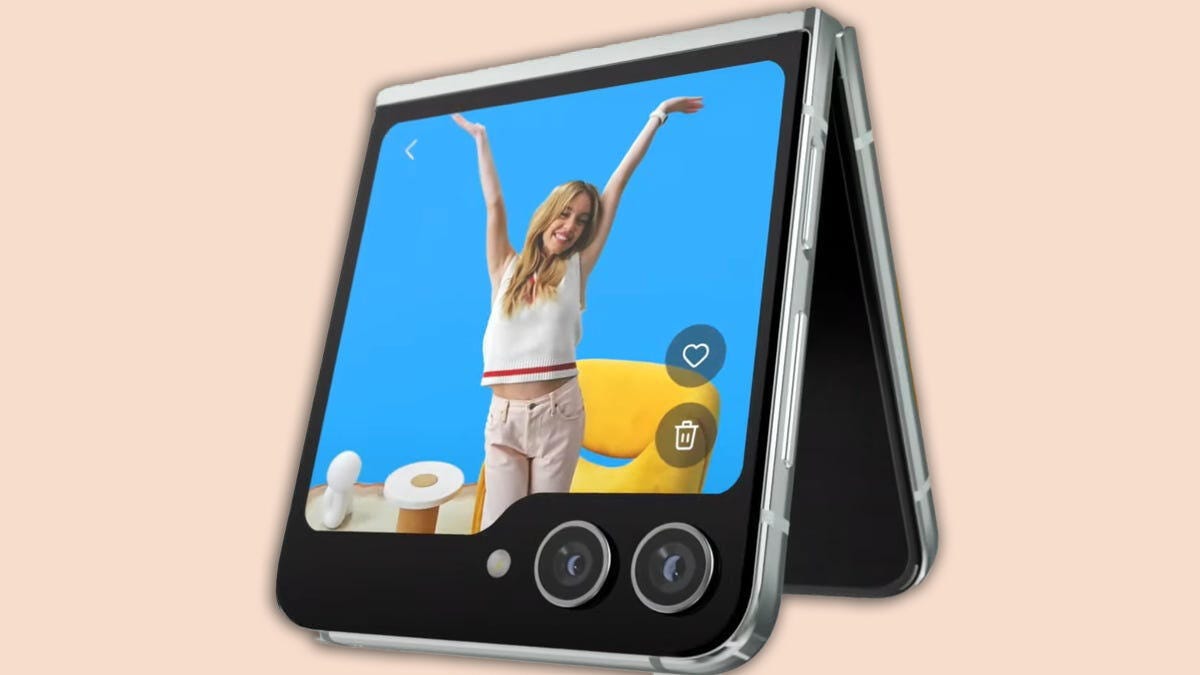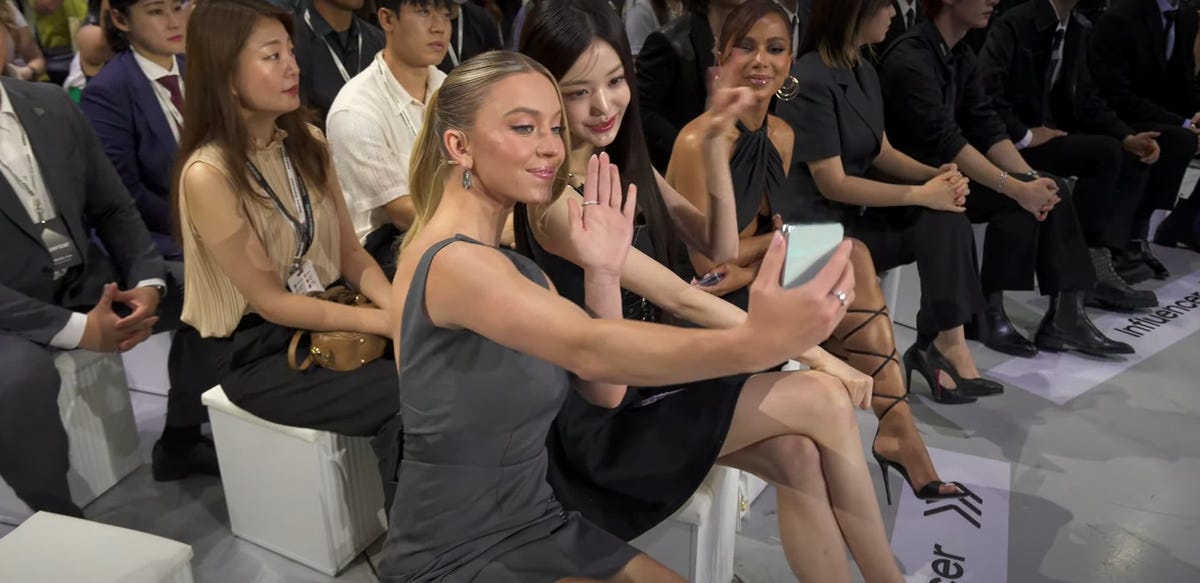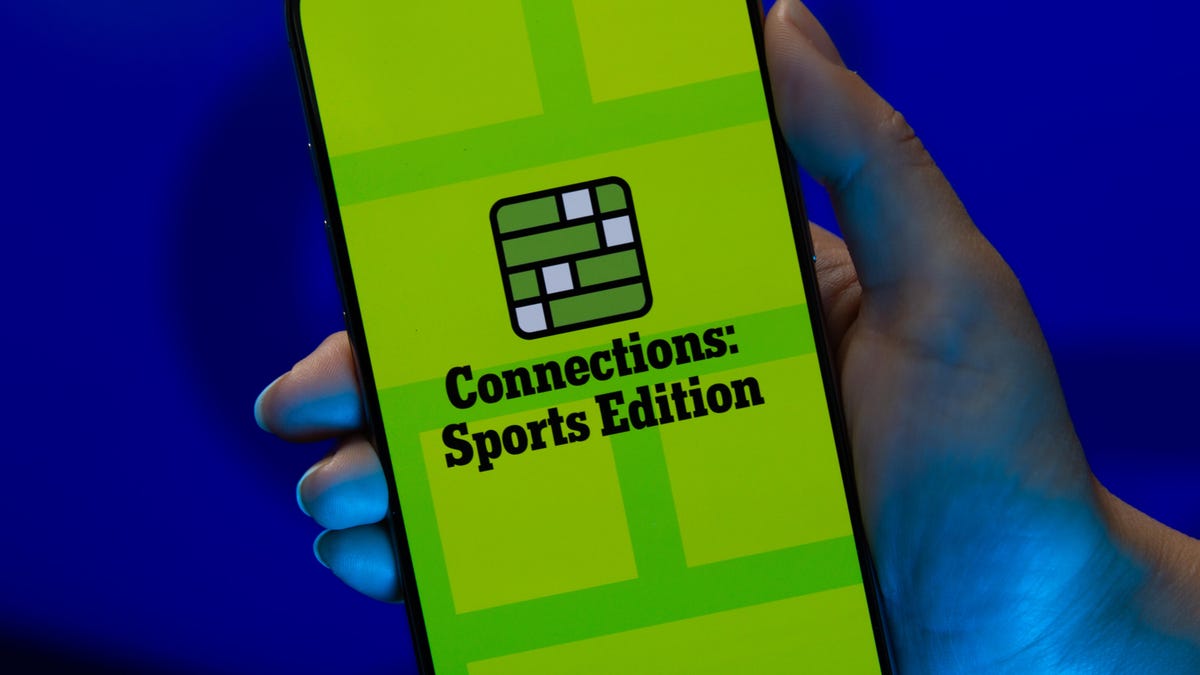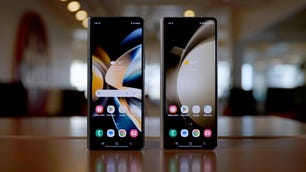Technologies
Will Gen Z Buy Into Flip Phones? Samsung’s Z Flip 5 Aims to Find Out
Persuading teen girls to part with their iPhones is no easy feat. But Samsung’s newest foldable could be the phone to convince them.

Cher Horowitz had one, Serena van der Woodsen had one, Lizzie McGuire had one, and now, in 2023, Sydney Sweeney has one. I’m talking about flip phones, which through the 1990s and early 2000s were the must-have tech status symbol for teen girls everywhere.
I should know, I was one of them. When I rocked up to university, it was with my trusty Motorola Razr — an icon of its time that was famously endorsed by another icon of that time: Paris Hilton.
Just as Motorola tapped Hilton in 2001, Samsung is now leaning heavily on Sweeney, star of the beloved-by-Gen Z HBO show Euphoria and part of the cast of The White Lotus’ first season, to try to convince the teens of today that they need a flip phone in their lives. Specifically, it wants to sell them the Samsung Galaxy Z Flip 5, which it unveiled in Seoul, South Korea, along with the heftier Galaxy Z Fold 5 phone, Galaxy Tab S9 and Galaxy Watch 6 during last week’s Unpacked event.
New and notable features of the Z Flip 5 include a larger cover screen on the front of the phone and a new hinge that allows it to sit fully flat when open and close completely with no gap. It goes on sale Aug. 11, and you can preorder the phone starting at $1,000 (£1,049, AU$1,649). CNET’s Lisa Eadicicco has been using one and says it’s a «step in the right direction» for Samsung.
Sweeney appeared at the event, both in a video and in person with a slicked-back ponytail and short gray dress, taking part in a live demo where she snapped a selfie with K-Pop idol Wonyoung. It’s the cross-cultural brand collaboration of dreams, and a savvy move by Samsung if it wants to appeal to teen girls globally. And it appears that it does.
In its ad for the Z Flip 5, Sweeney says the phone is a «game-changer» for when she’s filming videos on her own and talks about how her favorite part is the option to personalize it to fit her own style. With retro pastel graphics, the ad is designed to be catnip to young women. But Samsung still has a fight on its hands if it wants to convince this audience that the Z Flip 5 should be their next upgrade.
The fate of flip phones
Sadly for the flip phone, it’s a design that fell out of favor with teen girls (and everyone else) with the rise of the smartphone. For the past 15 years, the ubiquitous slimline slab is the only style of phone that’s been worth having — perhaps until now. Over the past few years, makers of Android phones have been developing their own foldable phones, including new generations of the Razr and the newly introduced Google Pixel Fold, packing flexible displays that can be flipped out to increase the screen size. Still, foldable phones accounted for only 1.2% of phone shipments last year, according to IDC, with Samsung dominating that category.
The majority of these phones are similar in size to a standard smartphone, and double in screen size when unfolded. But the Z Flip is half the size of a standard phone, and expands to the size of most smartphones in fold-out mode, making it ideal for people who like the idea of carrying a smaller device — a teenage girl, perhaps?
The «vintage» clamshell design of the flip phone has the potential to pique the interest of Gen Z users, most of whom are largely loyal iPhone users, according to a Financial Times report from February. There’s also some anecdotal evidence to suggest that some teens are already ditching their smartphones in favor of «dumb» old-school flip phones, according to CNN and other media reports. The Z Flip 5 offers the best of both worlds — the nostalgic look and feel of yesterday’s tech, with the cutting-edge features of today’s.

It’s notable, said CCS Insight chief analyst Ben Wood, that Samsung’s marketing and advertising campaigns for the phone heavily feature women and female influencers. (Its other products are all largely promoted by members of male K-Pop band BTS.) Android phone users have historically skewed slightly male, according to CCS research, with manufacturers struggling to attract as many female users. But the Z Flip 5 could provide some real competition to the iPhone in this regard, and the inclusion of Sweeney should «help drive interest in the product,» said Wood.
«Having an attractively designed device that offers a more compact alternative to an iPhone may be more appealing to female customers, and anecdotal feedback so far seems to suggest the Flip form factor does resonate well with women,» he said.
Flippin’ pricey
One potential roadblock for the Z Flip 5 on its way to winning the hearts and minds of teens everywhere is price. Foldable phones have struggled on the whole to gain mainstream traction at least in part due to their $1,000-plus price tags. The Z Flip 5 comes in at just under this, at $999, making it more affordable than most. (For contrast, Samsung’s other foldable phone, the Z Fold 5, starts at $1,800.)
It could be in Samsung’s favor that the improvements it’s made to this year’s Z Flip offer better value for money, said Anisha Bhatia, senior analyst at GlobalData.
«Samsung is following its Galaxy S23 strategy by giving consumers ‘more’ for the same price in this time of inflationary stress,» she said. «The Flip 5 costs the same as its predecessor at $999 but doubles the base storage to 256 GB.»
Make no mistake: That’s still a hefty amount to part with whether you’re a young person or a parent of one. But no high-end phone these days comes cheap, and the Z Flip 5 offers a lot for the money, while standing out in a crowded market with its unique design.
If any phone can tempt Euphoria and K-Pop fans to embrace Android and foldable screen technology, it wouldn’t be surprising if the Z Flip 5 is the one to do it.
Technologies
You Can Watch an Exclusive Avatar: Fire and Ash Scene on TikTok Right Now
Disney and TikTok partner on an immersive content hub for James Cameron’s latest movie about the alien Na’vi.
If you’re not quite ready to head to the theater to watch Avatar: Fire and Ash, an exclusive scene preview might sell you on the visual spectacle. As part of a new collaboration with the social media giant, Disney is posting snippets of its new movie to its TikTok account.
This scene isn’t part of any trailer and won’t be posted to other social media accounts, making TikTok the only place you can view it — unless you buy a movie ticket. A first look at the new movie’s scenes isn’t the only Avatar-related bonus on the social media platform right now, either. TikTok has partnered with the house of mouse to bring an entire «immersive content hub» to the app.
A special section of TikTok includes quizzes and educational videos that explore the alien world of Pandora shown off in the movies. On TikTok, you can take a personality quiz to find out what Na’vi clan you most closely align with and unlock a special profile picture border to use on your account.
Science and fiction blend together with a series of videos from real doctors who explain the basis for some of Avatar’s world-building. If you want to learn about exoplanets or how realistic the anatomy of the movie’s alien animals is, these videos will feed your brain while still providing entertainment value.
Perhaps the most enticing part of Disney’s latest social media collaboration is the opportunity for fans to win prizes and trips. TikTok creators who make edits with the #TikTokAvatarContest hashtag are entered into a competition to win Avatar merchandise. The biggest winners will be able to take a trip to visual effects studio Wētā Workshop in New Zealand or visit Avatar director James Cameron’s Lightstorm Entertainment Studio in Los Angeles.
Avatar: Fire and Ash is the third installment in director Cameron’s cinematic passion project. While the first Avatar movie was released in 2009, Cameron didn’t release another entry in the franchise until 2022. In total, there is a five-movie arc planned for the indigo alien Na’vi on the moon of Pandora.
The Avatar movies are known for pushing the boundaries of CGI visual effects in cinema. They are also historically big winners at the box office: the original Avatar is the highest-grossing film of all time, earning $2.9 billion across its theatrical releases. Its sequel, Avatar: The Way of Water, is the third-highest-grossing film of all time, trailing Avengers: Endgame. You can stream those movies on Disney Plus.
It remains to be seen whether Avatar: Fire and Ash will financially live up to its predecessors. The film currently has mixed reviews from critics on Rotten Tomatoes.
Technologies
Brain-Inspired Algorithms Could Dramatically Cut AI Energy Use
A new study dives into a major redesign for AI architecture.

One major issue facing artificial intelligence is the interaction between a computer’s memory and its processing capabilities. When an algorithm is in operation, data flows rapidly between these two components. However, AI models rely on a vast amount of data, which creates a bottleneck.
A new study, published on Monday in the journal Frontiers in Science by Purdue University and the Georgia Institute of Technology, suggests a novel approach to building computer architecture for AI models using brain-inspired algorithms. The researchers say that creating algorithms in this manner could reduce the energy costs associated with AI models.
«Language processing models have grown 5,000-fold in size over the last four years,» Kaushik Roy, a Purdue University computer engineering professor and the study’s lead author, said in a statement. «This alarmingly rapid expansion makes it crucial that AI is as efficient as possible. That means fundamentally rethinking how computers are designed.»
Don’t miss any of our unbiased tech content and lab-based reviews. Add CNET as a preferred Google source. Don’t miss any of our unbiased tech content and lab-based reviews. Add CNET as a preferred Google source.
Most computers today are modeled on an idea from 1945 called the von Neumann architecture, which separates processing and memory. This is where the slowdown occurs. As more people around the world utilize data-hungry AI models, the distinction between a computer’s processing and memory capacity could become a more significant issue.
Researchers at IBM called out this problem in a post earlier this year. The issue computer engineers are running up against is called the ‘memory wall.’
Breaking the memory wall
The memory wall refers to the disparity between memory and processing capabilities. Essentially, computer memory is struggling to keep up with processing speeds. This isn’t a new issue. A pair of researchers from the University of Virginia coined the term back in the 1990s.
But now that AI is prevalent, the memory wall issue is sucking up time and energy in the underlying computers that make AI models work. The paper’s researchers argue that we could try a new computer architecture that integrates memory and processing.
Inspired by how our brains function, the AI algorithms referred to in the paper are known as spiking neural networks. A common criticism of these algorithms in the past is that they can be slow and inaccurate. However, some computer scientists argue that these algorithms have shown significant improvement over the last few years.
The researchers suggest that AI models should utilize a concept related to SNNs, known as compute-in-memory. This concept is still relatively new in the field of AI.
«CIM offers a promising solution to the memory wall problem by integrating computing capabilities directly into the memory system,» the authors write in the paper’s abstract.
Medical devices, transportation, and drones are a few areas where researchers believe improvements could be made if computer processing and memory were integrated into a single system.
«AI is one of the most transformative technologies of the 21st century. However, to move it out of data centers and into the real world, we need to dramatically reduce its energy use,» Tanvi Sharma, co-author and researcher at Purdue University, said in a statement.
«With less data transfer and more efficient processing, AI can fit into small, affordable devices with batteries that last longer,» Sharma said.
Technologies
Today’s NYT Connections: Sports Edition Hints and Answers for Dec. 17, #450
Here are hints and the answers for the NYT Connections: Sports Edition puzzle for Dec. 17, No. 450.

Looking for the most recent regular Connections answers? Click here for today’s Connections hints, as well as our daily answers and hints for The New York Times Mini Crossword, Wordle and Strands puzzles.
Today’s Connections: Sports Edition is pretty challenging. How well do you know French soccer? If you’re struggling with today’s puzzle but still want to solve it, read on for hints and the answers.
Connections: Sports Edition is published by The Athletic, the subscription-based sports journalism site owned by The Times. It doesn’t appear in the NYT Games app, but it does in The Athletic’s own app. Or you can play it for free online.
Read more: NYT Connections: Sports Edition Puzzle Comes Out of Beta
Hints for today’s Connections: Sports Edition groups
Here are four hints for the groupings in today’s Connections: Sports Edition puzzle, ranked from the easiest yellow group to the tough (and sometimes bizarre) purple group.
Yellow group hint: Put it on your noggin.
Green group hint: Goes before a division of the year.
Blue group hint: French football.
Purple group hint: Think Louisville Slugger.
Answers for today’s Connections: Sports Edition groups
Yellow group: Headgear.
Green group: Prefixes to -season.
Blue group: Ligue 1 teams.
Purple group: Batting ____.
Read more: Wordle Cheat Sheet: Here Are the Most Popular Letters Used in English Words
What are today’s Connections: Sports Edition answers?
The yellow words in today’s Connections
The theme is headgear. The four answers are cap, hat, mask and visor.
The green words in today’s Connections
The theme is prefixes to -season. The four answers are mid, off, post and pre.
The blue words in today’s Connections
The theme is Ligue 1 teams. The four answers are Lens, Marseille, Nice and PSG.
The purple words in today’s Connections
The theme is batting ____. The four answers are average, gloves, practice and stance.
Don’t miss any of our unbiased tech content and lab-based reviews. Add CNET as a preferred Google source.
-

 Technologies3 года ago
Technologies3 года agoTech Companies Need to Be Held Accountable for Security, Experts Say
-

 Technologies3 года ago
Technologies3 года agoBest Handheld Game Console in 2023
-

 Technologies3 года ago
Technologies3 года agoTighten Up Your VR Game With the Best Head Straps for Quest 2
-

 Technologies4 года ago
Technologies4 года agoBlack Friday 2021: The best deals on TVs, headphones, kitchenware, and more
-

 Technologies4 года ago
Technologies4 года agoVerum, Wickr and Threema: next generation secured messengers
-

 Technologies4 года ago
Technologies4 года agoGoogle to require vaccinations as Silicon Valley rethinks return-to-office policies
-

 Technologies4 года ago
Technologies4 года agoOlivia Harlan Dekker for Verum Messenger
-

 Technologies4 года ago
Technologies4 года agoiPhone 13 event: How to watch Apple’s big announcement tomorrow



